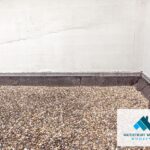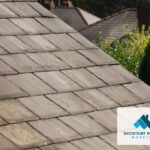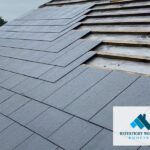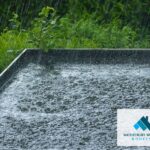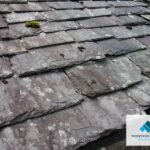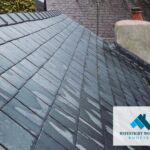Tired of feeling constrained by your roof? Yearning for freedom from traditional roofing styles? Look no further! This piece will look into the long-standing battle between pitched and flat roofing, and discuss their advantages and disadvantages in the UK.
Pitched roofing, with its classic charm and timeless appeal, is often associated with tradition and aesthetics. On the contrary, flat roofing is a symbol of modernity and practicality, offering a sleek and efficient alternative. But which one is right for you?
To make an educated decision, it’s essential to understand the key distinctions between these two options. We’ll look into factors like durability, longevity, cost implications, as well as how each type fares in the UK’s climate and regulations.
If you’re ready to break the confines of roofing and gain an insight into pitched vs. flat roofs in the UK context, read on!
Pitched Roofing: Traditional and Aesthetically Pleasing
Pitched roofing is the epitome of timeless beauty and adds a touch of elegance to any home, making it a must for those who crave traditional charm. Comparing pitched and flat roofs highlights the contrast between traditional and contemporary aesthetics.
Pitched roofs have been around for centuries and are often associated with classic architectural styles, such as Victorian or Tudor homes. Their steep slope allows rainwater to quickly run off, preventing leaks and water damage that could lead to structural issues.
Investing in a pitched roof can add considerable value to your property due to its traditional charm and historical significance. Appealing to many buyers, this timeless beauty can be a wise choice for homeowners looking to increase their property’s worth while embracing traditional vibes.
Flat Roofing: Modern and Functional
When it comes to roofs, you’ll find that flat roofing offers a modern and functional choice. Recently, flat roofs have gained traction due to their stylish and contemporary design. They provide a streamlined look that complements modern architecture.
One of the main advantages of flat roofing is its energy efficiency. The large surface area allows for the installation of solar panels, which can help reduce electricity bills and minimize your carbon footprint.
Furthermore, flat roofs are easier to maintain compared to pitched roofs. With regular inspections and proper drainage systems in place, you can avoid water pooling and potential damage.
Therefore, if you’re seeking a roof that looks attractive and provides practical benefits like energy efficiency, then flat roofing is worth exploring.
Durability and Longevity
When it comes to durability and longevity, pitched roofing has a clear advantage in its resistance to harsh weather conditions. Its sloped design makes it better equipped to manage heavy rain, snow, and wind. Materials used for pitched roofing, such as tiles or shingles, provide strength and prevent damage.
Flat roofing also offers its own strengths in terms of durability and longevity. Flat roofs have the capacity to carry heavy loads, including HVAC units or solar panels. Plus, they have effective waterproofing features to prevent leaks and guarantee long-term protection.
Ultimately, which type of roofing is best for durability and longevity will depend on your needs and preferences. Pitched roofs are excellent for harsh weather protection, while flat roofs offer strength and superior waterproofing. Carefully consider these factors when selecting the right roof for your property’s longevity requirements.
Pitched Roofing’s Resistance to Harsh Weather Conditions
If you’re searching for a roofing choice that can withstand even the toughest weather conditions, you’ll be pleased to know that pitched roofs have a reputation for their great sturdiness. Here’s why pitched roofing is a great option:
- Increased protection: Pitched roofs have a steeper slope, causing rainwater and snow to quickly slide off. This helps avoid water from pooling and reduces the risk of leaks and water damage when compared to flat roofs.
- Better durability: Pitched roofs are made with strong materials like tiles or shingles, which can handle strong winds, heavy rains, and even hailstorms. This guarantees that your roof will stay intact during extreme weather events.
- Improved insulation: The sloping design of pitched roofs allows for better insulation against heat loss in winter and heat gain in summer. This boosts energy efficiency and reduces heating/cooling costs.
- Higher property value: A well-maintained pitched roof gives a great look to your home, increasing its overall value. Potential buyers appreciate the additional sturdiness and longevity offered by pitched roofing.
Choose a pitched roof if you want long-term protection against tough weather conditions while increasing your property’s value.
Flat Roofing’s Strength and Waterproofing Features
Despite its reputation as being weak and vulnerable to leaks, flat roofing has remarkable strength and waterproofing features. These roofs are designed to bear heavy loads and can even be employed for extra outdoor living areas. They are constructed with multiple layers of materials, such as asphalt, rubber, or PVC, which provide optimal protection from water infiltration.
Furthermore, flat roofs are more energy efficient compared to pitched roofs. This allows for effortless installation of solar panels and green roof systems, helping homeowners save on energy costs and reduce their carbon footprint.
On the other hand, pitched roofing’s architecture impacts the overall look of a building. The slope adds visual appeal and aids with water drainage during heavy rain or snowfall.
It is important to consider both the advantages and drawbacks of each roofing type before making a decision that meets your needs and preferences.
Cost Considerations
When considering the cost of a roofing system, there are a few key points to keep in mind.
Initial installation costs can vary depending on the type of roofing chosen. Pitched roofs tend to have higher installation costs than flat roofs due to their complex design and materials needed.
Maintenance and repair expenses should also be taken into account. Flat roofs may require more frequent maintenance and repairs than pitched roofs, which could result in higher long-term costs.
Regular maintenance, however, can help extend the lifespan of any roofing system and reduce future expenses.
Initial Installation Costs
The initial installation costs for pitched roofing may leave homeowners with a lighter wallet, while flat roofing offers a more budget-friendly alternative. When it comes to the cost of installing a roof, there are several factors to take into account.
Pitched roofs require more materials and intricate construction techniques, leading to a longer installation time and higher labor costs. On the other hand, flat roofs are simpler to install and require fewer materials, resulting in lower overall costs.
Pitched roofs often need less maintenance and have a longer lifespan compared to flat roofs. However, regular inspections and maintenance are still essential for both types of roofs to ensure their longevity and avoid any future issues.
Ultimately, selecting between pitched and flat roofing will depend on your budget and preferences in terms of looks and durability.
Maintenance and Repair Costs
Now that you understand the initial installation costs of pitched roofing and flat roofing, it’s important to consider the ongoing maintenance and repair costs.
Pitched roofing generally requires less attention in comparison to flat roofing. This is due to its sloped design, which allows rainwater and debris to easily slide off. As a result, the risk of water pooling or damage is reduced.
On the other hand, flat roofs have a greater likelihood of developing leaks or cracks over time. This is because of the lack of natural drainage. Additionally, flat roofs tend to be more expensive to fix due to their intricate construction and accessibility difficulties.
Pitched roofs generally have a longer lifespan than flat roofs. This can have an effect on your long-term maintenance costs.
Taking into account these factors will help you make an informed decision about which roofing option is best suited for your needs and budget.
Considerations for UK Climate and Regulations
When considering the UK climate and regulations, it’s important to think about how pitched roofing will fare in rain and wind. Its sloped design makes it well-suited to shed water and battle gusts of wind.
Flat roofing, however, must be carefully considered in terms of drainage systems to avoid pooling of water, as well as insulation requirements to ensure energy efficiency in colder climates.
Knowing these points will help you decide which roof type is best for your needs in the UK.
Pitched Roofing’s Ability to Withstand Rain and Wind
Despite its reputation for being leaky and vulnerable, pitched roofing is actually quite adept at withstanding heavy rain and strong winds. The steep slope of a pitched roof allows rainwater to quickly run off, preventing any pooling or leakage. Additionally, the overlapping shingles or tiles create a watertight barrier, further protecting the underlying structure from water damage.
When it comes to wind resistance, the angled design of a pitched roof helps to reduce wind uplift forces, allowing the air to flow smoothly over the surface. This makes pitched roofing a reliable choice in areas prone to high winds.
In contrast, flat roofing systems can be more susceptible to leaks and wind damage. They require regular maintenance to guarantee proper drainage and prevent standing water from causing structural issues. While flat roofs offer energy efficiency benefits such as space for solar panels or rooftop gardens, their durability in harsh weather conditions may not match up to that of pitched roofs.
Overall, if you’re searching for a roofing option that can withstand rain and wind while demanding minimal maintenance, pitched roofing is a great choice for UK climates.
Flat Roofing’s Drainage and Insulation Requirements
Flat roofs require regular maintenance to ensure proper drainage and prevent any issues that may arise from standing water. Installing efficient drainage systems is essential for flat roofs, as they don’t naturally shed water like pitched roofs. Here are some key points to consider regarding flat roofing’s drainage and insulation needs:
- Drainage systems: Flat roofs need well-designed and correctly installed drains, gutters, or scuppers to effectively channel rainwater away. Obstructed or inadequate drainage can lead to ponding water, which can cause structural harm or leaks.
- Insulation materials: Flat roofs require insulation to regulate temperature and reduce energy loss. Common insulation options include rigid foam board, modified bitumen membranes with built-in insulation layers, or spray foam insulation.
- Proper installation: It’s essential to hire experienced roofers who understand how to properly install the selected drainage system and insulation materials for a flat roof.
By guaranteeing proper drainage and utilizing suitable insulation materials, you can maintain a functional and efficient flat roof that keeps your property sheltered from moisture-related issues.
Frequently Asked Questions
Are pitched roofs more expensive than flat roofs?
Pitched roofs may cost more initially, but they offer better value in the long run. Their greater durability and lower maintenance costs result in fewer repairs and replacements over time, potentially saving you money. So, while the upfront cost may be higher, the long-term savings can make it worth it.
Can I install solar panels on a pitched roof?
Yes, you can install solar panels on a pitched roof. Many people prefer it because it offers greater efficiency and simpler upkeep compared to flat roofs. When installing solar panels on a pitched roof, it’s important to consider the angle and orientation to get the most out of sunlight exposure. Flat roofs may require special mounting systems to ensure the right solar panel placement.
What types of materials are commonly used for flat roofs?
EPDM and PVC are two commonly employed materials for flat roofs. EPDM is a synthetic rubber membrane with superior longevity and UV ray resistance. It requires minimal upkeep and has a long lifespan. PVC, on the other hand, is a thermoplastic membrane that provides good flexibility and strength. Both materials offer benefits such as waterproofing and easy installation.
Additionally, green roofs are gaining popularity for flat roofing due to their environmentally friendly qualities such as improved insulation and rainwater management.
Are pitched roofs more resistant to strong winds and heavy rainfall?
Pitched roofs generally offer better protection against strong winds and heavy rainfall than flat roofs. Their sloping design allows rainwater and debris to easily slide off, reducing the risk of leaks and water damage. Furthermore, the sturdier structure of pitched roofs provides better protection against extreme weather conditions. This results in less maintenance needed in terms of repairs and replacements due to weather-related issues, making them a reliable choice for areas prone to severe weather events.
Are there any specific regulations or requirements for flat roofs in the UK?
In the UK, there are particular regulations and requirements for flat roofs that you need to take into account. These regulations guarantee that your flat roof is constructed to a high standard and complies with all safety standards.
For example, there could be limitations on the kinds of materials used or the installation process. Furthermore, appropriate maintenance is vital for flat roofs to avoid issues such as leaks and water damage. Regular inspections and repairs can help extend the lifespan of your flat roof.
We want to take the time to thank you for reading our article, please consider checking out our roofing services below:


